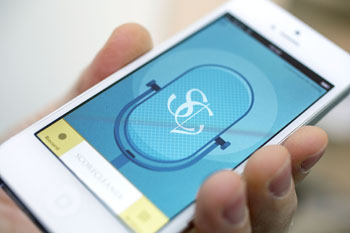A noteworthy app
The mobile becomes a music writing tool
Innovators
Need some instant musical notation to remember that little tune you just came up with? A new mobile app – created by a Computer Science engineer from KTH Royal Institute of Technology and a professor from KMH Royal College of Music – makes it possible to score any melody instantly and share it.

The ScoreCleaner Notes application listens to your melody, instantly writes it out in musical notation, and then makes it possible to share the written music via social media websites or email, says Sven Emtell, who started developing the background technology as part of his computer engineering master’s degree project at KTH with collaborator Sven Ahlbäck, who is now a professor at KMH Royal College of Music.
Users need not know how to read or write music, Emtell says. Even playing an instrument is optional. The user can hum or sing the melody into their mobile’s microphone, and the app instantly displays the notation on the screen, with the right key, tempo and time signature.
“We want to revolutionize the music industry,” Emtell says. “This app is revolutionary because it has the potential to unleash the creativity of musicians and music teachers worldwide."
With the growing interest in online musical collaboration, such an app could do just that.
"Musical notation is a universal language, so the market for this app is enormous.” Sven Emtell, researcher and co-founder of DoReMIR Music Research
One of the best-selling apps in Sweden for the last several months, ScoreCleaner Notes has been adopted by professional musicians and by elementary school music programs, among other customers, Emtell says. The app is available worldwide.
“Musical notation is a universal language, so the market for this app is enormous,” he says.
The way in which ScoreCleaner Notes listens to and understands musical structure is based on research into how people interpret music. The sound analysis function was developed with Anders Friberg, a docent in the Department of Speech, Music and Hearing at KTH.

Emtell and Ahlbäck started their company, DoReMIR Music Research, in 2006. Now they work there full time and their inventions are starting to take off. “We are developing the technology and have many exciting ideas for future products,” Emtell says, adding that “the end result is not always notation.”
Emtell says that ScoreCleaner Notes is superior to using a voice memo recorder for short passages of music. Notation is the best way to communicate musical ideas in most cases, he maintains. And for those familiar with notation, the interface offers an added advantage: It creates a directory in which each piece is represented by the first few notes. “This is worth gold for users to get an overview of the different recordings,” he says.“
A computer program version of the app, ScoreCleaner Notes Desktop, works like Google Translate for music, Emtell says. It understands and writes not only simple melodies played or sung by the user, but more complicated passages of music with multiple notes, or what is known by musicians as polyphony. All that is needed is a midi synthesizer connected to the computer, and the program automatically writes out the music with pitch and note values.
Thanks to the new link between the app and the software, the company expects contractors to soon be able to sell at a much broader market, he says.
“It feels good that we can promote music-making in society and facilitate musical communication between people.”
Katarina Ahlfort
Watch a demo of ScoreCleaner Notes